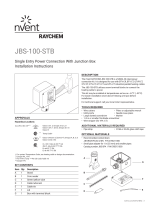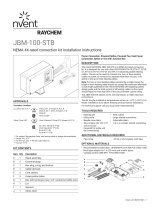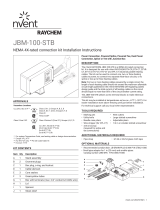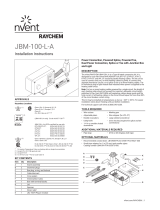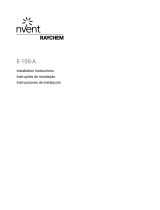La page est en cours de chargement...

DESCRIPTION
The nVent RAYCHEM E-100-L-A is a Type 4X-rated end seal kit with
a light that indicates voltage at the end of the circuit. It is designed
for use with nVent RAYCHEM BTV-CR, BTV-CT, QTVR-CT, XTV-CT,
KTV-CT, HTV-CT and VPL-CT industrial parallel heating cables. Once
installed, the end seal is easily re-entered for maintenance and the
heating cable can be accessed without removing the end seal. The
LED indicator light provides excellent visibility.
This kit may be installed at temperatures as low as –40°F (–40°C).
For easier installation store above freezing until just before
installation.
Kit is rated for 100 to 277 V.
Make sure voltage rating of light is the same as that of the
heat-tracing circuit.
For technical support call nVent at (800)545-6258.
TOOLS REQUIRED
• Wire cutters • Utility knife
• Needle nose pliers • Slotted screwdriver or nutdriver
• Panduit CT-100 crimp tool or equivalent
ADDITIONAL MATERIALS REQUIRED
• Pipe strap • nVent RAYCHEM GT-66 or GS-54
glass cloth tape
OPTIONAL MATERIALS
• Small pipe adapter for 1 in (25 mm) and smaller pipes:
Catalog number JBS-SPA P/N E90515-000
KIT CONTENTS
Item Qty Description
A 1 End seal stand and light assembly
B 2 Insulated parallel crimps
C 1 End seal label
D 1 Cable lubricant
E 1 Cable tie
F 1 Core sealer
B
D
C
E
Stand
A
F
Strain relief
Leash
Light
APPROVALS
CLI, ZN1, AEx e mb IIC T* Gb
(1)
ZN21 AEx tb IIIC T*
Ex e mb IIC T* Gb
Ex tb IIIC T***°C Db
Ex em IIC T* Gb
(2)
IECEx SIR 14.0007X
Ex e mb IIC T* Gb IP66
Ex tb IIIC T***°C Db
Hazardous Locations
Class I, Div. 2, Groups A, B, C, D
Class II, Div. 1 and 2, Groups E, F, G
Class III
(1)
Except VPL
(2)
Except KTV-CT
(3)
For HTV-CT only ** Per CE Code Table 18.
* For system Temperature Code, see heating cable or design documentation.
Class I Division 2 (Zone 2**), Groups A, B, C, D
Class I Zone 2 IIC
(3)
E-100-L-A
High-Profile Lighted End Seal InstallationInstructions
nVent.com/RAYCHEM | 1

2 | nVent.com/RAYCHEM
BTV-CR, BTV-CT, QTVR-CT
Bus wire
Conductive core
Inner jacket
Braid
Outer
jacket
Clear jacket
Inner jacket
Braid
Outer
jacket
Heating element
Insulated bus wire
Bus wire connection
VPL-CT
Inner jacket
Braid
Outer
jacket
Spacer
Conductive fiber
XTV-CT, KTV-CT HTV-CT
Bus wire
Outer Jacket
Braid
Conductive Core + Electrical Insulation
Bus Wire
This component is an electrical device that must be
installed correctly to ensure proper operation and to
prevent shock or fire. Read these important warnings
and carefully follow all of the installation instructions.
• To minimize the danger of fire from sustained
electrical arcing if the heating cable is damaged
or improperly installed, and to comply with the
requirements of nVent, agency certifications, and
national electrical codes, ground-fault equipment
protection must be used. Arcing may not be
stopped by conventional circuit breakers.
• Component approvals and performance are
based on the use of nVent-specified parts only.
Do not use substitute parts or vinyl
electrical tape.
• The black heating cable core and fibers are
conductive and can short. They must be
properly insulated and kept dry.
• Damaged bus wires can overheat or short. Do
not break bus wire strands when scoring the
jacket or core.
• Keep components and heating cable ends dry
before and during installation.
• Bus wires will short if they contact each other.
Keep bus wires separated.
• Use only fire-resistant insulation materials, such
as fiberglass wrap or flame-retardant foam.
• Leave these installation instructions with the
user for future use.
Health Hazard: Prolonged or repeated contact
with the sealant in the core sealer may cause skin
irritation. Wash hands thoroughly. Overheating or
burning the sealant will produce fumes that may
cause polymer fume fever. Avoid contamination of
cigarettes or tobacco. Consult MSDS VEN 0058 for
further information.
CHEMTREC 24-hour emergency telephone:
(800) 424-9300.
Non-emergency health and safety information:
(800) 545-6258.
Ce composant électrique doit être installé
correctement pour éviter les risques d'incendie
ou de chocs électriques. Lire ces avertissements
importants et suivre attentivement toutes les
instructions d'installation.
• Pour réduire le danger d'incendie causé par un
arc électrique entretenu, si le câble chauffant est
endommagé ou mal installé, et pour respecter
les exigences de nVent et celles des codes
applicables, il est impératif d'utiliser une protection
par disjoncteur différentiel. Les disjoncteurs
ordinaires ne sont pas toujours capables de
supprimer les arcs électriques.
• Les approbations et les performances des
composants sont basées sur l'utilisation des
pièces nVent spécifiées seulement. N'utilisez
pas de pièces de rechange ou de ruban isolant en
vinyle.
•
Le noyau et les fibres du câble chauffant noir sont
conducteurs et peuvent provoquer un court-circuit.
Ils doivent être correctement isolés et gardés à
sec.
• Les fils omnibus endommagés peuvent
surchauffer ou subir un court-circuit.
• Ne brisez jamais les fils omnibus lorsque vous
incisez la gaine ou le noyau.
• Maintenez les composants et les extrémités
des câbles chauffants secs avant et pendant
l'installation.
• Les fils omnibus peuvent provoquer un court-
circuit s'ils se touchent. Les garder à l'écart les uns
des autres
• N'utilisez que des matériaux isolants
ininflammables, par exemple une gaine de fibre de
verre ou de la mousse ignifuge.
• Laissez ces instructions d'installation à l'utilisateur
pour qu'il puisse les consulter.
DANGER POUR LA SANTÉ : Le contact prolongé
ou répété avec le produit d'étanchéité du noyau
peut provoquer une irritation de la peau. Lavez-
vous les mains soigneusement. La surchauffe et
la combustion du produit d'étanchéité produira des
vapeurs qui peuvent causer la fièvre des vapeurs de
polymères. Évitez la contamination des cigarettes ou
du tabac. Consultez la fiche technique santé-sécurité
(FTSS) VEN 0058 pour obtenir de plus amples
informations.
Téléphone en cas d'urgence 24 heures sur 24 de
CHEMTREC : (800) 424-9300
Renseignements non urgents en matière de santé et
de sécurité : (800) 545-6258
WARNING:
CAUTION:
HEATING CABLE TYPES
AVERTISSEMENT:
MISE EN GARDE:

nVent.com/RAYCHEM | 3
2 1/4 in
(57 mm)
24 in
(60 cm)
12 in
(30 cm)
45°
Indentation (bus wire
connection on VPL
heating cables only).
XTV, KTV
BTV, QTVR
Go to Step 5A
Go to Step 5B
Go to Step 5C
Go to Step 5D
VPL
HTV
12 in
(30 cm)
Drain hole
3
1
4
2
• Measure exactly 2 1/4 in (57 mm).
• Lightly score outer jacket around and down as shown.
• Bend heating cable to break jacket at score; peel off jacket.
• Remove all exposed braid.
• Allow approximately 24 in (60 cm) of heating cable for
installation. For VPL, cut cable 12 in (30 cm) from bus
indentation.
• Cut off heating cable end at about 45° for easier insertion.
• Apply lubricant for easier
insertion into stand.
• Optional: If stand is to
be installed on bottom
side of pipe, knock
out drain hole prior to
insertingcable.
• Slide heating cable
through stand.
• Square off cable end
with90° cut.
• Determine heating cable type and continue as shown.

4 | nVent.com/RAYCHEM
XTV, KTV
1 3/8 in
(35 mm)
Do not cut bus wires
5A
1/4 in
(5 mm)
1 3/8 in
(35 mm)
Do not cut bus wires
BTV, QTVR
5B
• Measure exactly
1 3/8 in (35 mm).
• Lightly score inner
jacket around and
down as shown.
• Peel off jacket.
• Cut and remove all
fiber strands.
• Score and remove
center spacer.
• Remove any remaining
fiber material from
bus wires.
• Measure exactly
1 3/8 in (35 mm).
• Lightly score inner
jacket around and
down as shown.
• Peel off jacket.
• Notch core.
• Peel bus wire from core.
• Score core between bus
wiresat inner jacket.
• Bend and snap core.
• Peel core from bus wire.
• Remove any remaining core
material from bus wires.
Go to Step 6 Go to Step 6

nVent.com/RAYCHEM | 5
Do not cut bus wires
HTV
1 3/8 inches
(35 mm)
1 3/8 inches
(35 mm)
180°
180°
5D
Go to Step 6
1 3/8 in
(35 mm)
1/2 in
(13 mm)
Do not cut bus wires
VPL
5C
• Measure exactly
1 3/8 in (35 mm).
• Lightly score inner
jacket around and
down as shown.
• Peel off inner jacket.
• Unwind heating
element, cut and
remove as shown.
• Lightly score clear
jacket around and
down as shown.
• Remove insulation
from ends of bus
wires.
Go to Step 6
• Measure exactly
1 3/8 in (35 mm)
• Score inner jacket
and conductive
core around and
down as shown.
• Flip the cable
180ºC and score
the other side of
inner jacket and
conductive core.
• Remove the inner
jacket, conductive
core by using
needle-nose pliers
as shown.
• Score and remove
center insulation.
• Remove any
remaining material
from bus wires.

6 | nVent.com/RAYCHEM
5/8 in
(15 mm)
Tubes
Make sure all strands
go into the tubes.
Make sure the bus
wires do not kink,
bunch, or crossover.
1 3/4 in
(44 mm)
Strain
relief
Braid
1/2 in
(13 mm)
6 7
8 9
10 11
• Mark the jacket
as shown.
• If needed, re-twist and straighten bus wires, then
insert bus wires into guide tubes as shown.
• Push core sealer onto the heating
cable to the mark made in step 6.
Note: Extra force may be required for
larger cables or at lower temperatures.
• Remove the guide tubes and
dispose of them in a plastic bag.
• Pull cable back through end seal stand until braid is just
visible above strain relief.
• Trim exposed
conductors.
CAUTION: Health Hazard. Wash hands after contact
with sealant. Consult material safety data sheet
VEN0058.
AVERTISSEMENT: risque pour la santé. Se laver les
mains après tout contact avec le produit
d’étanchéité. Consulter la fiche de données de
sécurité VEN 0058.

nVent.com/RAYCHEM | 7
Insulated
parallel
crimps
Be sure wires
are not caught
in threads.
13
14
• Place blue crimps
onto bus wires.
• Push excess wire
inside light.
• Tighten light onto end seal stand. Torque = 22 +– 2 Nm
Note: For 1-in
(25-mm) and smaller
pipes use adapter
(purchased
separately) between
stand and pipe.
Position
adapter this
side up.
JBS-SPA
adapter for
small pipes
• Fasten end seal stand to pipe with pipe strap. Do not pinch
heating cable. Be sure pipe strap is under heating cable.
• Loop and tape extra heating cable to pipe. Minimum bend
radius is 3/4 in (20 mm).
12
• Crimp bus wires to
lead wires.

nVent.com/RAYCHEM | 9
Troubleshooting Guide
Problem Troubleshooting steps
Light is dim
or off.
1. Check that light voltage rating matches supply voltage for heat-tracing circuit. Supply voltage lower or higher than light rating
will cause malfunctions.
2. Check that heat-tracing circuit is energized. Although the circuit breaker is on, control devices such as thermostats may switch
heating cable off.
3. Following electrical safety procedures, disconnect supply voltage, unscrew light from end seal base and check that crimp
connections to heating cable bus wires are tight and not crossed or shorted. Loose connections or shorts will cause malfunctions.
4. With circuit off, attach volt meter leads to crimps. Energize circuit and measure voltage at light. Use the following table to
determine whether the voltage measured is within the acceptable range.
• If voltage at light is in acceptable range and connections are good, the light may be defective or damaged. Replace light.
• If there is no voltage at the light, there may be breaks in the heating cable between the power connection and the end seal.
Check for splice or tee connections that may be left open.
• If voltage at light is above specified limits, the light may be off. Voltages above specified range can damage light. Replace light
with correct version for line supply voltage or adjust supply voltage accordingly.
• If voltage at light is present but below specified limits, the light may be dim or off. The following table lists typical causes for
low voltages and possible solutions.
Cause Solution
Supply voltage at start of circuit is low (light is designed to
work with supply voltages within 10% of nominal).
Increase power wire gauge size to reduce voltage drop
between panel and heating cable power connection.
Heating cable length is too long (light is designed to work
with published maximum circuit lengths).
Split heating cable into multiple circuits. Shorten length of
heating cable.
Heating cable is started under very cold conditions
(heating-cable voltage drop is very high for first minutes of
very cold start-up).
Wait for heating cable to warm up. Voltage at light
willincrease.
Heating cable controller is reducing voltage (light may not
work with controllers that phase fire to reduce linevoltage).
Turn off phase firing function in heating cable controller.
Problem Troubleshooting steps
Cap cannot be
tightened
completely.
1. Check that heating cable is installed and stripped correctly. The top of the insulated parallel crimps should be 2 3/8 in
(60mm), or less, above the top of the plastic strain relief in the stand.
2. Check that core sealer is positioned properly. The end of the core sealer must be flush against the plastic strain relief in
thestand.
3. Check that the threads on the light and stand are clean. The connection wires between the heating cable and the light should
not be caught in stand threads.

©2021 nVent. All nVent marks and logos are owned or licensed by nVent Services GmbH or its affiliates. All other trademarks are the property of their respective owners.
nVent reserves the right to change specifications without notice.
RAYCHEM-IM-H59141-E100LAendseal-EN-2104
nVent.com/RAYCHEM
North America
Tel +1.800.545.6258
Fax +1.800.527.5703
thermal.info@nVent.com
Europe, Middle East, Africa
Tel +32.16.213.511
Fax +32.16.213.604
thermal.info@nVent.com
Asia Pacific
Tel +86.21.2412.1688
Fax +86.21.5426.3167
cn.thermal.info@nVent.com
Latin America
Tel +1.713.868.4800
Fax +1.713.868.2333
thermal.info@nVent.com
1/12



